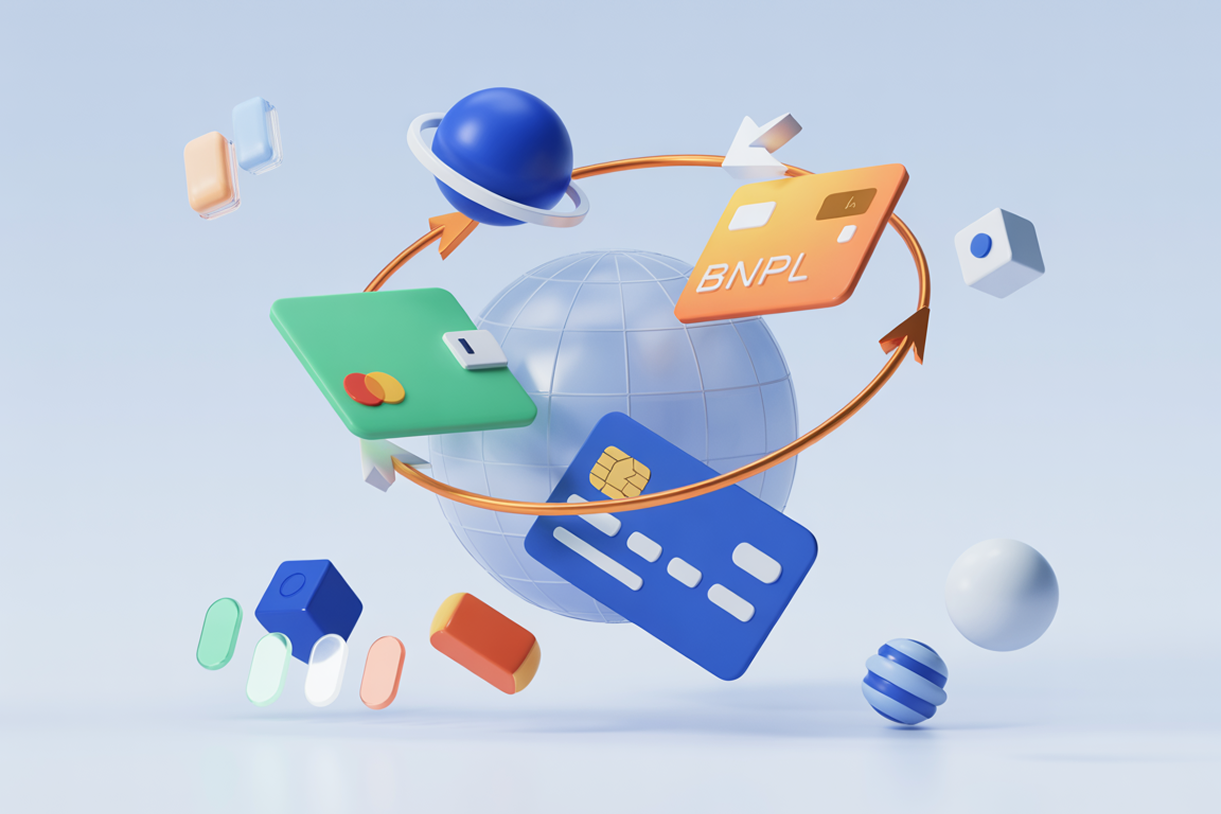Payment processors: What they are and how to choose one
This guide breaks down how payment processors work and what to look for - fees, features, and integration - when picking one for your business.

Payment processors handle 88% of all in-person purchases today, with cash accounting for just 12% of transactions. Just about every point of sale now has a digital dimension, which makes picking the right payment processor crucial for every business.
Selecting the best payment processor for a small business depends on more than simple fees. There are other factors to consider, including accepted payment methods, security protocols, support for international transactions and more. All of this often makes selecting a payment service a confusing and difficult choice.
That's why we've put together this comprehensive guide on payment processors. We'll help you understand what they are, how they work, and what to consider when choosing the best payment processing platform for your needs.
What's in this article?
- What is a payment processor?
- What do payment processors do?
- How do payment processors work?
- Payment processor integration for small businesses
- Cost considerations and fee transparency
- How to choose a payment processor
What is a payment processor?
Payment processors are companies that move funds between bank accounts. They complete transactions for credit cards, debit cards, bank transfers and digital wallet sales, enabling businesses to accept various forms of payment securely and facilitating the transfer of funds from the customer's account to the business's account.
What do payment processors do?
Payment processors play a critical role in the online payments ecosystem, enabling businesses to accept and process various forms of payment from customers. Here's an overview of their primary functions:
[fs-toc-omit]Transaction facilitation
Payment processing system receive transaction details when customers make purchases and securely transmit this information to the appropriate parties, including the issuing bank (customer's bank) and acquiring bank (merchant's bank), via the card network.
[fs-toc-omit]Authorization and authentication
The payment processor requests authorization from the issuing bank to ensure that the customer has sufficient funds or credit available. It also verifies the customer's identity and the validity of the payment method to minimize fraud and unauthorized transactions.
[fs-toc-omit]Encryption and security
To protect sensitive financial data, payment processors use encryption and tokenization to securely transmit transaction data between the customer, business and banks. They must comply with the Payment Card Industry Data Security Standard (PCI DSS) to maintain a secure environment for handling cardholder information.
[fs-toc-omit]Settlement and funding
Once a transaction is authorized, the payment processor coordinates the transfer of funds from the issuing bank to the acquiring bank. The merchant account is then credited with the transaction amount, minus any applicable fees.
[fs-toc-omit]The role of issuing and acquiring banks
Every transaction involves two important banks - the issuing bank and the acquiring bank. The issuing bank gives customers their credit or debit cards and manages their accounts, checking for sufficient funds, watching for fraud and approving or declining purchases. The acquiring bank helps merchants accept digital payments, receiving transaction requests from payment processors and sending them through card networks to the issuing bank. These banks communicate through card networks like Visa or Mastercard, which provide the framework and rules that help money move safely from customers to merchants.
[fs-toc-omit]Fraud detection and prevention
Payment processors use advanced algorithms and tools to monitor transactions for fraudulent activity, helping businesses minimize their exposure to fraud. They also provide support and assistance in handling chargebacks and disputes.
[fs-toc-omit]Reporting and analytics
Payment processors produce data about customer payments that can be used to generate transaction reports, analytics and insights to help businesses track sales, identify trends and manage their businesses more effectively.
[fs-toc-omit]Support for multiple currencies and payment methods
To help businesses expand globally, many payment processors offer support for multiple currencies and popular local payment methods, allowing businesses to operate internationally and receive payouts in local currencies.
How do payment processors work?
Payment transactions might seem instant to customers, but there is a complex technical process going on behind the scenes. So let’s dive into how payment processing works.
First of all, it’s crucial to understand that there are multiple financial entities that work together anytime someone swipes, taps or enters their credit card in a sophisticated sequence of electronic communications.
So apart from payment processor, that can also involve card reader, card processor, and payment gateway.
Everything moves at lightning speed through several verification stages while ensuring security, confidentiality and accuracy.
Here's a detailed look at a typical payment processing flow:
- Customer initiates payment Customers enter their payment details at checkout through a physical point-of-sale (POS) terminal, an online checkout page, a mobile app, or through payment links.
- Transaction data encryption The merchant's payment gateway encrypts the sensitive payment information before sending it to the payment processor. This encryption helps prevent fraudulent actors from intercepting and misusing sensitive customer information.
- Transaction data transmission The encrypted transaction data is sent from the business to the payment processor, which then forwards the information to the acquiring bank.
- Acquiring bank to issuing bank The acquiring bank forwards the transaction details to the issuing bank through the appropriate card network (e.g., Visa, Mastercard, or American Express) for authorization.
- Authorization request The issuing bank reviews the transaction details and checks if the customer has sufficient funds or credit available. It also confirms the authenticity of the payment method and the customer's identity to mitigate the risk of fraud.
- Authorization response If the issuing bank approves the transaction, it sends an authorization code back to the acquiring bank through the card network. If the transaction is declined, the issuing bank sends a decline message explaining why the transaction was not approved.
- Processor receives response The payment processor receives the response from the acquiring bank and forwards it to the business. If the transaction is authorized, the business can proceed with the sale. If it's declined, the business must request an alternative payment method from the customer.
- Transaction completion Once the transaction is authorized, the business delivers the goods or services to the customer. At this point, the transaction is considered complete, although the actual transfer of funds is still yet to occur.
- Capture and settlement Typically, at the end of the day, the business sends a batch of authorized transactions to the payment processor for settlement. The payment processor then submits this batch to the acquiring bank, which initiates the process of transferring funds from the issuing bank to the merchant account. This transfer usually takes 1-3 business days, depending on the specific processor and bank involved.
[fs-toc-omit]Authorization and settlement - the two stages of all electronic payments
Payment processing happens in two separate phases - authorization and settlement:
Authorization comes first and checks if the payment method is legitimate. The customer's bank looks at account status, available funds and possible signs of fraud. An approval means the bank holds the funds temporarily. This step just confirms the customer can pay - no money goes anywhere just yet.
Settlement happens later, sometimes taking hours or days after authorization. This is when actual money changes hands. Merchants usually group their authorized transactions at day's end to settle them. The temporary hold becomes a real debit from the customer's account and money is transferred to the merchant.
Payment processing providers use this two-step process to keep everyone safe. Merchants know they'll get paid before giving out products or services. Customers keep control of their money until the transaction finishes. Small businesses can use this knowledge to pick payment processors that handle both steps reliably and quickly.
Payment processor integration for small businesses
Small businesses need a digital payment processor that integrate smoothly with their existing systems to create an intuitive checkout experience. Your payment system's technical fit with your business tools determines how well you can process payments and run your operations.
[fs-toc-omit]API capabilities
Leading payment processors offer complete API capabilities that handle almost any payment scenario a small business needs. Key API features include:
- Real-time transaction processing that confirms payments instantly and keeps cash flowing
- Support for multiple payment methods, including major credit cards, digital wallets like Apple Pay and Google Pay, and international payment options
- Custom integration options through robust APIs that meet specific technical needs
Businesses with technical teams benefit from API-first design, allowing them to build custom checkout experiences or use tokenization to secure payment data. Modern platforms also handle subscriptions, marketplace transactions and multi-currency support across 135+ currencies.
[fs-toc-omit]Integration and compatibility
Choose a payment processor that is compatible with your existing e-commerce platform, POS system or other business software. Most processors provide easy-to-use APIs, plugins or SDKs that allow for seamless integration with various platforms.
[fs-toc-omit]Mobile and in-person payments support
Today's small businesses must accept payments anywhere. Modern payment processors give you options that enable flexible sales strategies:
- Cross-channel commerce that helps businesses identify returning customers whether they buy online or in person, creating customized experiences like product suggestions or easy in-store pickup for web orders
- Tap to Pay technology that lets businesses take contactless payments right on their compatible smartphones or tablets without extra hardware - especially useful for mobile businesses, pop-up shops and field service providers
- Hardware flexibility - some processors work with both their own and other card readers
- Offline functionality for operating where internet connection is spotty
- Custom mobile app integration for creating branded payment experiences
Your technical skills and business model should guide your integration choice. Quick-setup options need minimal configuration, while API integrations offer more customization but take longer to develop.
Payment processors - Costs and fees
Payment processing companies charge fees for the conveniences they deliver. Those fee structures vary and can play an important role in determining which one is right for any given business. Processing rates typically differ for in-person and online transactions, with online fees tending to be higher because of the nature of the transaction and the extra steps involved.
[fs-toc-omit]Understanding payment processor fees
Credit card processing costs typically range from 1.5% to 3.5% per transaction, with the total amount consisting of three main components:
- Interchange fees: These non-negotiable fees go to the card-issuing bank and make up the largest part of processing costs
- Assessment fees: Card networks (Visa, Mastercard, etc.) charge 0.13% to 0.15% of each transaction
- Processor markup: Payment processors add their profit margin, ranging from 0.1% to over 1%
Most processors also add various monthly costs on top of transaction charges. Statement fees, account maintenance fees, and payment gateway fees cost between $5 to $25 monthly. Some processors offer pay-as-you-go models without any setup fees or monthly charges.
[fs-toc-omit]Other costs and fees for payment processing services
Watch out for these frequently overlooked expenses:
- PCI compliance fees: These charges help merchants meet PCI DSS requirements and typically range from $79 to $120 per year, or are charged monthly, quarterly or included in overall processing fees. Not all providers charge this fee.
- Early termination fees: Contract cancellation penalties typically cost $200 to $500
- Chargeback fees: Customer disputes cost $15 to $40, whatever the outcome
- Minimum monthly fees: Businesses pay these when transaction volumes fall below specified thresholds
Before selecting a payment processor, be sure that you have a good understanding of all the potential extra costs that you may face on top of those charged per transaction.
[fs-toc-omit]Volume-based discounts and surcharging options
Higher transaction volumes unlock tiered discounts for merchants. It makes sense to go with a payment processor that charges less for higher volumes if your business can consistently achieve sufficient sales figures.
As a vendor, you can also add surcharges to credit card payments but this strategy needs careful attention to regulations. Surcharge amounts must stay below your merchant discount rate for the specific credit card and cannot exceed 3% in most states. Ten US states currently restrict such surcharging. Clear disclosure rules apply - businesses must display surcharge information at entrances and list the surcharge amount on all receipts.
You also have to consider the possible customer pushback against any such surcharge and how to communicate it in a way that does not result in lost sales.
How to choose a payment processor
Payment processors directly impact the customer experience, transaction security, cash flow and overall efficiency of the payment process. Choosing a payment processor requires a good understanding of exactly what you need, both now and in the future as your business grows and evolves. Here are the key factors you should consider:
[fs-toc-omit]Security and compliance
Security plays a vital role in handling customer payment data. All of the top payment processors offer enhanced security measures and any reputable brand will meet or exceed industry standards. Look for these essential security features:
- PCI DSS Compliance: The Payment Card Industry Data Security Standard is the most fundamental security standard - a global set of requirements established by major card brands that mandates how businesses store, process, and transmit cardholder data
- Encryption: Transforms sensitive data (like credit card numbers) into an unreadable, scrambled format using complex algorithms and encryption keys
- Tokenization: Replaces sensitive payment data with a unique, randomly generated, non-sensitive string of characters called a "token" that has no value if intercepted
- Regular Security Audits: Frequent security audits, vulnerability scans, and penetration testing to identify and address weaknesses
- Secure Software Development: Following secure coding practices and maintaining regular updates and patching to address newly discovered vulnerabilities
[fs-toc-omit]Accepted payment methods
Ensure that the payment processor supports the payment methods that your customers are most likely to use. These could include credit cards, debit cards, digital wallets, buy now pay later (BNPL), and any locally relevant payment options. Offering a variety of payment methods can increase customer satisfaction and conversion rates.
[fs-toc-omit]Fees and pricing
Understand the complete fee structure of the payment processor, which may include setup fees, transaction fees, monthly fees, chargeback fees and currency conversion fees. Look for a pricing model that aligns with your business's transaction volume and anticipated growth. Some processors offer tiered pricing or flat rates, while others charge based on a percentage of each transaction plus a fixed fee.
[fs-toc-omit]International support
If your business operates in multiple countries or plans to expand globally, look for a payment processor that supports multiple currencies and popular local payment methods. Also, assess their currency conversion fees and international transaction fees.
[fs-toc-omit]Customer support
Leading payment processors now offer round-the-clock customer service as standard practice. Check to see if it's included in the plan you choose and under what conditions - access to live chat with customer service representatives, possible limitations on the number of priority interactions, timeframes for resolving issues, etc. Check online reviews and testimonials to gauge the responsiveness and helpfulness of their support team.
[fs-toc-omit]Fraud prevention and account freeze protocols
Key protections to look for include:
- Address Verification Service (AVS) checks that flag suspicious transactions with mismatched billing addresses
- Machine learning algorithms that detect unusual purchase patterns
- Multi-factor authentication protocols that verify user identity
Processors may freeze accounts if they detect unusual activity. You can minimize disruptions by keeping accurate transaction records and using strong fraud detection tools.
[fs-toc-omit]Ease of use and customer experience
Evaluate the checkout user experience for customers as well as the reporting and transaction management experience for businesses. The interface should be intuitive, user-friendly and efficient.
[fs-toc-omit]Scalability and flexibility
As your business grows, your payment processing needs will evolve. Look for a processor that can scale with your business and that offers features such as subscription billing, invoicing and recurring payments. Think about what your payment processing needs might look like in five years and make sure that the payment processor is able to support your future business needs.
[fs-toc-omit]Contract terms and cancellation policies
Review the payment processor's contract terms, including any minimum requirements, early termination fees or other potential limitations. Look for a processor with transparent and flexible terms that suit your business needs.
Choose your payment processor wisely
Just as with other ecommerce tools, there is no one generic solution that works the same for everyone when it comes to online payment processors. Technical compatibility between payment systems and business infrastructures will vary. Different cost and fee structures will match different kinds of businesses. Things like customization or mobile payments may or may not be relevant to every operation.
The good news is there are lots of options when it comes to payment processors and one of them is likely to stand out once you start looking into them. The downside is the time and effort you have to put into the research.
But getting to know the details is worth it. After all, payment processors facilitate overall business efficiency, shape your customer experience, guarantee transaction security and contribute to customer trust. Take your time to review options against your needs before you commit. A good processor becomes more than just a vendor - it becomes a strategic collaborator that helps grow your business and keeps your customers' trust with every transaction.
Related articles
Ready for more? Check out these related articles that will keep your momentum going. They’re packed with easy-to-follow tips and tricks to help you supercharge your digital goods business.
Take it easy with Easytools
Focus on creating, and let Easytools handle the behind the scenes work.





